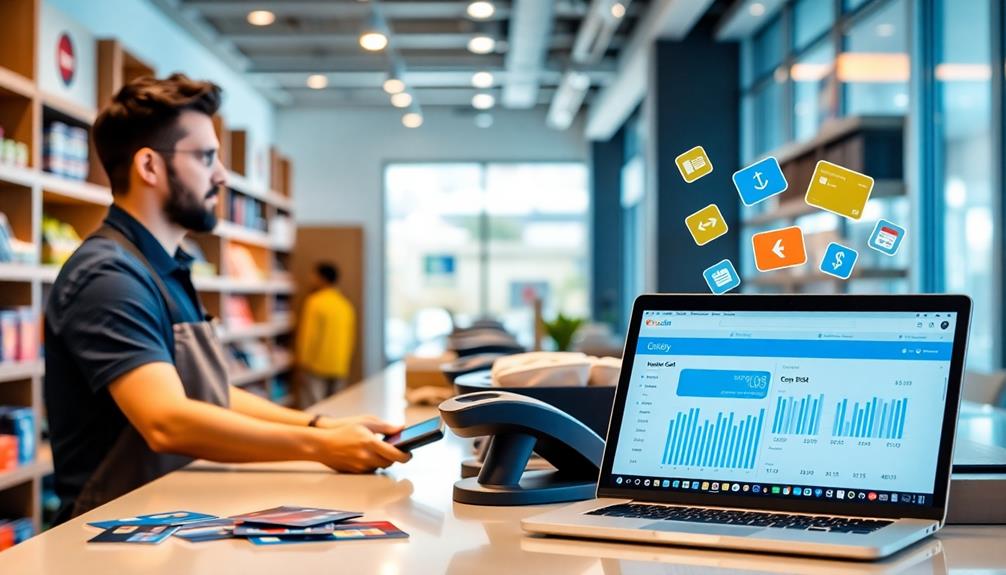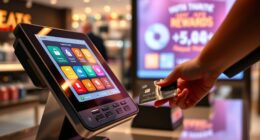Design tweaks to your card art can impact fraud rates by influencing how easily counterfeiters can copy security features like holograms and microtext. Attractive visuals may draw attention but could also compromise the integrity of embedded security elements if not carefully integrated. Balancing aesthetic appeal with robust security features is essential to prevent vulnerabilities. By understanding this dynamic, you’ll discover strategies to enhance both the look and safety of your cards effectively.
Key Takeaways
- Design tweaks that weaken security features can increase fraud vulnerability, while well-integrated enhancements can deter counterfeit attempts.
- Visual elements like holograms with microtext and shifting images improve authentication and reduce fraud risks.
- Overly elaborate or poorly integrated designs may compromise structural integrity and create security gaps.
- Balancing aesthetic appeal with embedded security features enhances fraud prevention without sacrificing visual impact.
- Regular updates to design elements based on emerging threats help maintain effective fraud deterrence.

While eye-catching card art can make your card stand out, security should always be your top priority. When designing your card, it’s tempting to focus on vibrant graphics, intricate hologram designs, or unique patterns that catch the eye. However, these aesthetic choices can influence how easily your card can be forged or manipulated. One aspect to contemplate is the magnetic stripe, which remains a common method for card authentication. If you opt for a simple or poorly protected magnetic stripe, it could be more vulnerable to skimming attacks. Thieves can clone the stripe data if it’s not sufficiently encrypted or protected by security features. Including complex hologram designs isn’t just about visual appeal; it’s a critical security feature. Holograms are difficult to duplicate and serve as a quick visual verification tool for merchants and cardholders alike. When your hologram incorporates specific patterns, microtext, or shifting images, it becomes harder for fraudsters to counterfeit your card successfully. These small details act as a first line of defense, discouraging attempts at duplication.
Additionally, employing innovative security features in your hologram and overall design can significantly reduce the risk of fraud. However, it’s essential to understand that aesthetic enhancements shouldn’t compromise security. For instance, a hologram that’s overly elaborate or poorly integrated with the card’s surface might create vulnerabilities if it affects the card’s structural integrity or interferes with security features like the magnetic stripe. Conversely, a well-designed hologram that aligns seamlessly with the card’s overall security architecture can serve as a visual deterrent to fraud. Security features like hologram designs are not just ornamental; they’re embedded with microtext, color-shifting elements, or embedded images that are difficult to reproduce without specialized equipment. When combined with a secure magnetic stripe, these features create a layered defense, making it markedly harder for criminals to forge or tamper with your card. Additionally, incorporating advanced security features into your card’s art can further enhance protection against fraud. Ensuring that all design elements are integrated with security standards helps maintain the integrity of your card’s defenses.
Furthermore, staying informed about emerging security threats and adapting your card’s design accordingly can provide an ongoing safeguard against fraud attempts. Ultimately, any change to your card’s design—whether adding new hologram designs or modifying the magnetic stripe—must prioritize security. While eye-catching art can improve branding and customer appeal, it shouldn’t come at the expense of security integrity. The best approach balances attractive design elements with proven security features, ensuring your card remains both appealing and safe from fraud. Remember, sophisticated security measures embedded within your card’s art, like advanced hologram designs, can be a powerful deterrent, helping protect your financial information in an increasingly digital world.
Frequently Asked Questions
How Does Card Art Influence Consumer Perception of Security?
You might assume that card design influences how secure you feel using it. Visual perception plays a big role, as a professional, clear, and trustworthy design can boost your confidence in the card’s security features. When a card looks trustworthy, you’re more likely to trust its security measures. A well-designed card can positively impact your perception of safety, making you feel more comfortable and confident in its ability to protect your financial information.
Are There Industry Standards for Card Design and Security Features?
Becoming bold in branding, many banks balance beauty and security by following industry standards. You’ll find guidelines that guarantee brand consistency while meeting security compliance, safeguarding your cards against fraud. While there’s no universal rule, institutions typically adhere to established security standards like EMV chip technology and CVV codes. Staying compliant and consistent helps you create secure, stylish cards, fostering trust and thwarting fraud with a focused, firm foundation.
Can Aesthetic Changes Impact the Effectiveness of Security Features?
You might think aesthetic changes don’t impact security, but visual deception can actually influence how easily fraudsters bypass features. When you tweak card design, branding influence can distract or mislead, potentially hiding security elements. While some aesthetic updates enhance appeal, they could unintentionally reduce the effectiveness of security features if they create confusion or obscure essential details. So, it’s essential to balance visual appeal with security considerations carefully.
What Role Does Customer Feedback Play in Card Design Decisions?
You rely on customer feedback to shape your card designs by ensuring branding consistency, enhancing customer engagement, and meeting user needs. Listening to your customers helps you identify preferences, address concerns, and create designs that resonate. By prioritizing their input, you foster loyalty, improve satisfaction, and make informed decisions that strengthen your brand. Customer feedback becomes a essential tool for balancing aesthetics with functionality, ultimately guiding your design choices effectively.
How Do Different Markets Approach Balancing Design and Security?
You’ll find that different markets balance design and security by prioritizing branding influence while ensuring security compliance. In some regions, striking a balance means creating visually appealing cards that still meet strict security standards. Others may emphasize security compliance more heavily, making subtle design tweaks to enhance fraud prevention. Your approach depends on understanding local preferences and regulations, ensuring the card’s aesthetic aligns with branding goals without compromising essential security features.
Conclusion
As you glance at your card’s design, it’s no coincidence that small tweaks can make a big difference in security. Just like a hidden thread in a fabric, subtle changes can catch the eye of fraudsters before they strike. So, next time you see a new card design, remember—it’s more than just looks; it’s a carefully woven shield, blending art and security to keep your financial world safe and sound.










